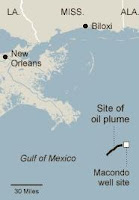Study: Oil plume is not breaking down fast
The New York Times reports: New research confirms the existence of a huge plume of dispersed oil deep in the Gulf of Mexico and suggests that it has not broken down rapidly, raising the possibility that it might pose a threat to wildlife for months or even years.
 The study, the most ambitious scientific paper to emerge so far from the Deepwater Horizon spill, casts some doubt on recent statements by the federal government that oil in the gulf appears to be dissipating at a brisk clip. However, the lead scientist in the research, Richard Camilli, cautioned that the samples were taken in June and circumstances could have changed in the last two months.
The study, the most ambitious scientific paper to emerge so far from the Deepwater Horizon spill, casts some doubt on recent statements by the federal government that oil in the gulf appears to be dissipating at a brisk clip. However, the lead scientist in the research, Richard Camilli, cautioned that the samples were taken in June and circumstances could have changed in the last two months.
The paper, which is to appear in Friday’s issue of the journal Science, adds to a welter of recent, and to some extent conflicting, scientific claims about the status of the gulf. While scientists generally agree that the risk of additional harm at the surface and near the shore has diminished since the well was capped a month ago, a sharp debate has arisen about the continuing risk from oil in the deep waters.
So far, scientific information about the gulf has emerged largely from government reports and statements issued by scientists. Many additional research papers are in the works, and it could be months before a clear scientific picture emerges.
The slow breakdown of deep oil that Dr. Camilli’s group found had a silver lining: it meant that the bacteria trying to eat the oil did not appear to have consumed an excessive amount of oxygen in the vicinity of the spill, alleviating concerns that the oxygen might have declined so much that it threatened sea life. On this point, Dr. Camilli’s research backs statements that the government has been making for weeks.
Dr. Camilli, of the Woods Hole Oceanographic Institution in Woods Hole, Mass., said the plume, at the time he studied it, was dissipating so slowly that it could still be in the gulf many months from now. Assuming that the physics of the plume are still similar to what his team saw in June, “it’s going to persist for quite a while before it finally dissipates or dilutes away,” he said.
Concentrations of hydrocarbons in the plume were generally low and declined gradually as the plume traveled through the gulf, although Dr. Camilli’s team has not yet completed tests on how toxic the chemicals might be to sea life.
 The study, the most ambitious scientific paper to emerge so far from the Deepwater Horizon spill, casts some doubt on recent statements by the federal government that oil in the gulf appears to be dissipating at a brisk clip. However, the lead scientist in the research, Richard Camilli, cautioned that the samples were taken in June and circumstances could have changed in the last two months.
The study, the most ambitious scientific paper to emerge so far from the Deepwater Horizon spill, casts some doubt on recent statements by the federal government that oil in the gulf appears to be dissipating at a brisk clip. However, the lead scientist in the research, Richard Camilli, cautioned that the samples were taken in June and circumstances could have changed in the last two months.The paper, which is to appear in Friday’s issue of the journal Science, adds to a welter of recent, and to some extent conflicting, scientific claims about the status of the gulf. While scientists generally agree that the risk of additional harm at the surface and near the shore has diminished since the well was capped a month ago, a sharp debate has arisen about the continuing risk from oil in the deep waters.
So far, scientific information about the gulf has emerged largely from government reports and statements issued by scientists. Many additional research papers are in the works, and it could be months before a clear scientific picture emerges.
The slow breakdown of deep oil that Dr. Camilli’s group found had a silver lining: it meant that the bacteria trying to eat the oil did not appear to have consumed an excessive amount of oxygen in the vicinity of the spill, alleviating concerns that the oxygen might have declined so much that it threatened sea life. On this point, Dr. Camilli’s research backs statements that the government has been making for weeks.
Dr. Camilli, of the Woods Hole Oceanographic Institution in Woods Hole, Mass., said the plume, at the time he studied it, was dissipating so slowly that it could still be in the gulf many months from now. Assuming that the physics of the plume are still similar to what his team saw in June, “it’s going to persist for quite a while before it finally dissipates or dilutes away,” he said.
Concentrations of hydrocarbons in the plume were generally low and declined gradually as the plume traveled through the gulf, although Dr. Camilli’s team has not yet completed tests on how toxic the chemicals might be to sea life.



Comments